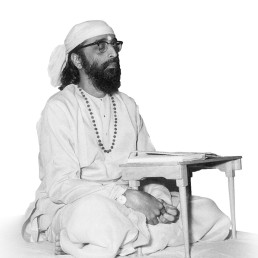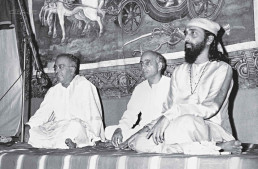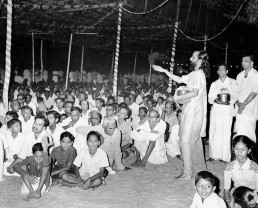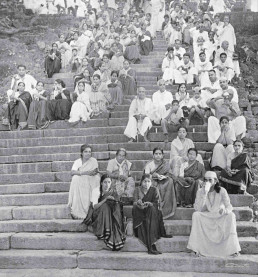
Jnana Yajna 64

Year & Dates:
December 06, 1959 to December 26, 1959

Yajna Topic:
Shrimad Bhagavad Gita- Chapter 2

Place:
Mangalore, India.
Mangaluru had savored, for the first time in 1958, the transformational taste of Vedanta through Pujya Gurudev’s Jnana Yajna. So, when the news spread that He was coming to enlighten all on the treasured wisdom of Srimad Bhagavad Gita – Chapter 2, auspicious cheer filled Mangaluru. The Government College Authority hastened to offer the biggest of its playgrounds as the yajnashala for Pujya Gurudev’s 64th Jnana Yajna.
The inauguration at 6 pm on Dec.6, 1959 was marked with delight and discipline for dedicated learning. The Chinmaya Bala Vihar children who offered flower petals and chanted the Gita delighted Pujya Gurudev. The discipline which the audience displayed indicated their eagerness. And, Dr. T. M. P. Mahadevan, the head of the Department of Philosophy in Madras University and a great exponent of Bhagavan Ramana Maharshi’s teachings, inaugurated the Gita Jnana Yajna.
Blessed by Bhagavan Krishna
At Mangalore, in the morning sessions that started at 7:30 am, Pujya Gurudev first completed the final verses of Atma Bodha left unexplained from the previous yajna. By that very act, Pujya Gurudev indicated how He cared for the seekers’ thorough understanding. Only after that, did He launch into the glorious Mundakopanishad as the audience doubled in number.
The sparks from the second chapter of Gita were brilliant. To learn how to serve and then come to deserve, to look at death as simply a change from a worn-out attire, to elevate duty with knowledge and surrender, to adopt the qualities of a Sthitaprajna witnessing life like one of those two symbolic birds of Mundakopanishad -the Upanishad in the morning and the Gita in the evening just flowed into each other and flowed through the aspirants.
Hearing how enriching Pujya Gurudev’s Gita Jnana Yajna was, His Holiness Swami Raghumanya Thirtha, pontiff of Palimar Mutt (1947-2000), met Pujya Gurudev who offered the Madhwa sannyasi a separate stage and invited him to address the audience in Kannada on the final day of the yajna.
Pujya Gurudev then visited the temple for Sri Krishna installed over 850 years ago in Udupi by Sri Madhwacharya, the Master of Dvaita philosophy. That evening, a young black cow walked regally into the yajnashala during Pujya Gurudev’s description of the “Divine Song of Gopalanandana” and unhurriedly moved through the thousands close to the dais where Pujya Gurudev was and then exited quietly. Later when a devotee wondered aloud, “Was it Gopalakrishna who had paid a return visit to Pujya Gurudev?” Pujya Gurudev just smiled.
The eye-and heart catching Laksharchana, the Gangajal Prokshana with the holy Ganges water brought down from Rishikesh, and the reverential Guru Dakshina ceremony with the prasad booklet entitled “As I think” made the yajnashala a powerhouse of spirituality. The crowning touch to the Jnana Yajna was the yatra to the sacred temple of Lord Subrahmanya. The 300 devotees were immersed in the bliss of satsang with Pujya Gurudev and the Avabhruta Snana in the nearby river ‘Kumaradhari.’ When Pujya Gurudev directed the group to meditate in solitude in a scenic river bed at the confluence of the Netravati and the Kumaradhari rivers, the serene silence that engulfed all was the lasting takeaway from a noteworthy yajna.
Photo Gallery

“Think,” Says Pujya Gurudev
The three inseparable Gunas always remain in the inner constitution of every living creature in varying proportions. The mind and intellect are constituted of this stuff. To go beyond these three temperaments is to literally go beyond the mind. If there is an alloy constituted of copper, Zinc and tin, and a pot is made of that alloy, then to remove all tin, zinc and copper from the pot is to destroy the pot completely. Tea is made of hot water, tea leaves, sugar and milk; and form a cup of tea if you are asked to remove these four aspects of it, it amounts to saying ‘empty the cup’, In the direct language of the Upanishads, man has been advised to transcend the mind and intellect, and they promise that the individual shall thereby re-discover himself to be God. This direct explanation came to frighten the Hindu folk out of the Arvan-fold and here the Call of the Renaissance also means the same but puts it in different words when it says: “Arjuna, transcend the Gunas.”
From Tyagi Magazine
Where is your Mind?
Delve into the Bhagavad Gita’s teachings on mindful living and learn how to integrate its principles into your everyday activities. Explore the concept of yoga as dexterity in action and uncover practical strategies for staying present and focused in all your endeavors.









